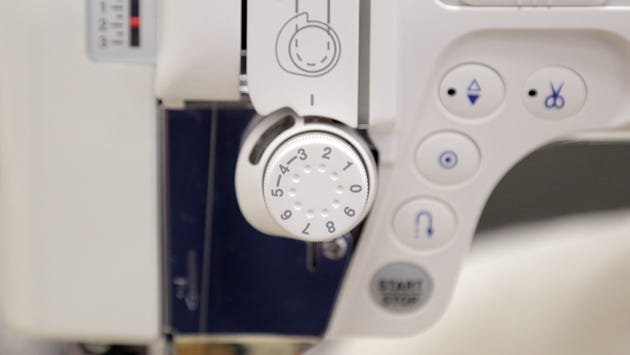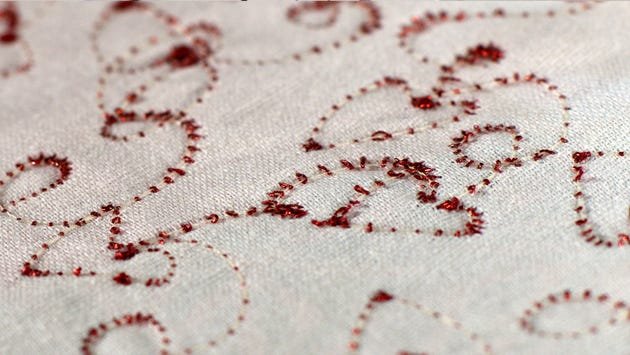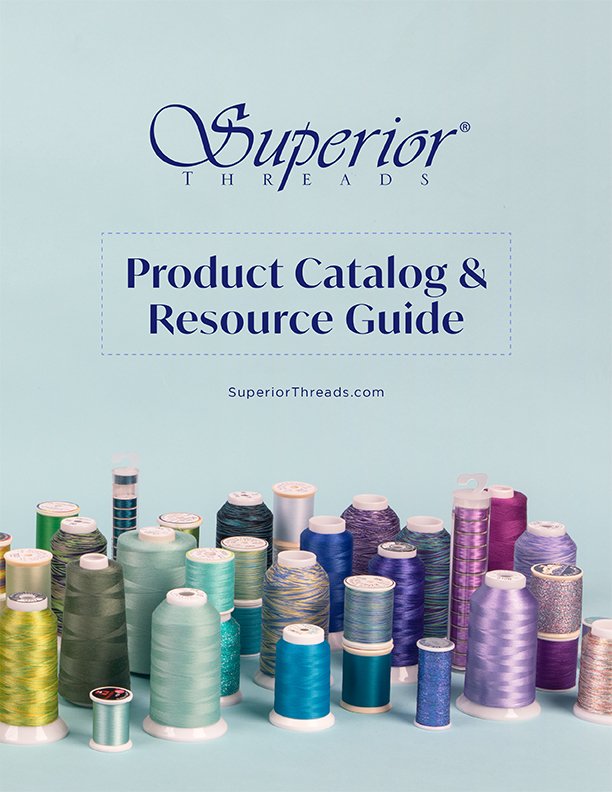Superior Education
SEWING MACHINE TENSION
- TENSION ADJUSTMENTS
- TUG OF WAR
- TOP THREAD
- BOBBIN THREAD
How does tension affect the outcome of a stitch?
Sewing machines are factory preset to have the top and bottom thread form even stitches when sewing with a 50 or 60 wt. thread. If the top and bottom threads are identical in fiber and weight, adjustments may not be necessary. However, if we use cotton thread on top and polyester thread underneath, or metallic thread on top and polyester thread underneath, or a heavy thread on top and a fine thread underneath, it is necessary to adjust the tension settings. It is perfectly OK to use different thread types and weights on the top and bottom. Relying on a machine's automatic tension system is not enough.
Think of the top and bottom thread as having a tug of war. If the threads are identical and you are sewing on a single layer of fabric, both sides have equal strength and the result will be a draw. The sewing should therefore produce perfectly even stitches with no top thread showing underneath and no bobbin thread showing on top. However, in the real world, the teams are rarely equal. One team will be stronger or bigger or faster than the other. We sometimes use decorative or sensitive threads on top. We often use different fibers for the top and bottom threads. We also add stabilizer or batting. Sometimes we might use a cotton bobbin thread and other times we use a polyester bobbin thread. All these factors make it necessary to adjust the tension for each project. By adjusting the top tension either up (increasing tension) or down (decreasing tension), we are able to add or take away strength on the top thread team to equalize the tug of war.

A sewing machine's top tension settings

When the top tension is too loose, looping on the back may occur
What most commonly affects stitch balance?
Batting
Batting adds drag on the top thread. Depending on the loft and density, batting can put more stress on the thread during stitch formation. This results in an increase of stress applied to the top thread. Cotton batting tends to grab the thread more than polyester batting, adding more friction on the thread.
Fabric
If you are sewing on a densely-woven fabric, such as batiks, duck cloth, or denim, the top thread will be exposed to a greater degree of friction. Fabrics that have a looser weave, such as quilting cotton and knits allow for the top thread to pass through the individual fibers in the fabric with less friction, and thus with less tension applied to the thread during stitch formation.
Top Thread
The thickness and material of the top thread can affect stitch quality and stitch balance. If the top thread is a thick, 30 wt. polyester thread and the bobbin thread is a fine, 60 wt. cotton thread, the top tension will most likely need to be adjusted (loosened) to accommodate an even stitch. It is not a problem to mix fiber types, cotton thread on top and polyester thread in the bobbin, or thickness, 40 wt. thread on top and a 50 wt. thread in the bobbin. Some threads require very loose tension in order to achieve balanced stitches. Metallic thread, for example, is a beautiful decorative thread. However, it is not as strong as a 40 wt. polyester quilting thread and will need the top tension reduced to 1.0 (very loose). When the appropriate tension adjustments are made, you can use a mixture of threads and obtain balanced stitches.
Bobbin Thread
Cotton threads tend to have more grab to them compared to a smooth, filament polyester thread. Sometimes, a thread with a little grab is preferred, such as when piecing a quilt together. This is why a low-lint cotton thread like MasterPiece is recommended for piecing and sewing quilts together. With sewing applications such as topstitching a quilt, a smooth bobbin thread may be preferred, especially when quilting with decorative threads like metallic.
We've created an easy-to-understand diagram to help illustrate the thread tug of war. We recommend that you print this guide and keep it close to your machine and share it with your friends and fellow guild members. By keeping the top and bottom thread in balance, you will mitigate problems with broken and uneven stitches, allowing you to spend more time sewing and quilting with less time troubleshooting problems that arise from uneven tension.

 View Our Product Catalog
View Our Product Catalog